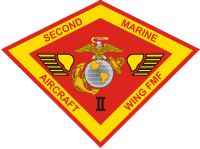MCARA Units > 2nd MAW HEDRON-2 AEW/ECM Section (1950-52)
Also See:
2nd MAW Headquarters Squadron (HEDRON-2) AEW/ECM Section History
Airborne Electronic Counter Measures (ECM) was in its infancy in WWII and evolved with USAAF and Navy efforts in the European theater. This new capability was extended to the Pacific war in 1944 and 1945 by both the Navy and USAAF, the latter mainly with ECM operators in the B-29 aircraft flying against the Japanese homeland targets where the Japanese were employing Early Warning radars to advantage. The Navy apparently had some ECM equipment installed in some of their PBY4-1s. These efforts were mainly focused on interception of enemy radar signals although some rudimentary radar jammers may have been employed. There is no record of the Marine Corps acquiring or employing airborne ECM in WW II.
 The first official record of a Marine Corps unit employing ECM designated aircraft was in 1950 with the Second Marine Aircraft Wing’s Headquarters Squadron (HEDRON-2). The squadron had an Airborne Early Warning (AEW) and ECM Section which operated 3 AD-3W Skyraiders and the 2 TBM-3Q Avengers, the later for ECM. Navy TBM-3s were modified into the 3Q versions as early as 1946 and by 1948 an official Handbook of Instructions with Parts Catalog was published by the Bureau of Aeronautics indicating that the modifications were being performed by a Navy aircraft rework facility. It is likely HEDRON-2 received its TBM-3Q aircraft circa 1950 from one of those facilities.
The first official record of a Marine Corps unit employing ECM designated aircraft was in 1950 with the Second Marine Aircraft Wing’s Headquarters Squadron (HEDRON-2). The squadron had an Airborne Early Warning (AEW) and ECM Section which operated 3 AD-3W Skyraiders and the 2 TBM-3Q Avengers, the later for ECM. Navy TBM-3s were modified into the 3Q versions as early as 1946 and by 1948 an official Handbook of Instructions with Parts Catalog was published by the Bureau of Aeronautics indicating that the modifications were being performed by a Navy aircraft rework facility. It is likely HEDRON-2 received its TBM-3Q aircraft circa 1950 from one of those facilities.
The early aircraft assignment records were confirmed by a written personal history of the origins of airborne ECM in the Marine Corps by Major Daniel C. Georgia, one of our ECM pioneers. He confirms that their organization was the only one in the Marine Corps that had an ECM capability. (Note: all that follows is directly attributed to his written history).
Then SSgt. Georgia, an electronics technician, joined HEDRON-2 in December 1950 and underwent on-the-job training on the TBM-3Q’s ECM equipment which included the AN/APR-4 Receiver and the AN/APA-11 Pulse Analyzer used to intercept and classify radar signals. The aircraft was configured with a manually rotated dipole antenna that was extended from the fuselage belly and used by the ECM operator wearing earphones to detect an audible null determining a line of position to the radar. Additionally, there was a chute used to drop chaff or Window as it was called then. The aircraft could optionally carry an early radar jamming transmitter, the AN/APQ-2, although Georgia mentions they were not allowed to use it. (not sure whether for classification or friendly radar interference reasons)
Georgia lists the following personnel in the section when he joined:
Pilots:
|
Maj. Thomas H. Mann (OIC) Capt. Edward H. Rice Capt. C. F. Hughes Msgt Mike Butchko Msgt Cal Voekler (Leading Chief) |
Aircrew: | Maj. Runyon -Electronics Officer Maj. Arvid Jouppi -ECM Officer Msgt. Joe Bouher - NCOIC Msgt. Doc Grimes Msgt. Lee Aller SSgt. Dan Georgia SSgt. Peter J. McNulty |
Apparently only a few of the listed aircrew actually received ECM training as the primary mission of the section was AEW which evolved around the AD-3W with its APS-20A radar. Major Jouppi was the main ECM instructor, and Georgia thought that he had WW II experience in airborne ECM but Major Reece Woodard, a former room mate of Jouppi says he served in WW II as a ground electronics officer. The training focused on identification of a radar signal and determining its operating frequency and pulse width. Given the rudimentary state of the art, Georgia credits Jouppi as the only ECM operator able to locate a radar with the TBM equipment! They were not allowed to do any electronic jamming but did an occasional window or chaff drop using the chute. Georgia noted the aircraft leaked badly and they found out the hard way that water logged chaff didn’t work very well.
An early report from Korea indicated that the North Koreans may be using radar controlled antiaircraft guns and the radar was thought to operate at about 100 megahertz. The unit was directed to modify an existing transmitter (presumably a An/APQ-2) to allow this radar to be jammed. The project was undertaken by Msgts. Bouher and Grimes and they eventually were able to modify two transmitters to operate in that frequency range. During the Summerof 1951, Bouher and Grimes were ordered to Korea with their two jammers. (They were assigned to 1st MAW Hedron-1 and formed the second ECM section there using two AD-2Q aircraft assigned to MAG-33.)
The HEDRON -2 AEW/ECM section later became the nucleus of VMC-2 which was commissioned in May, 1952 at MCAS Cherry Point, NC.

